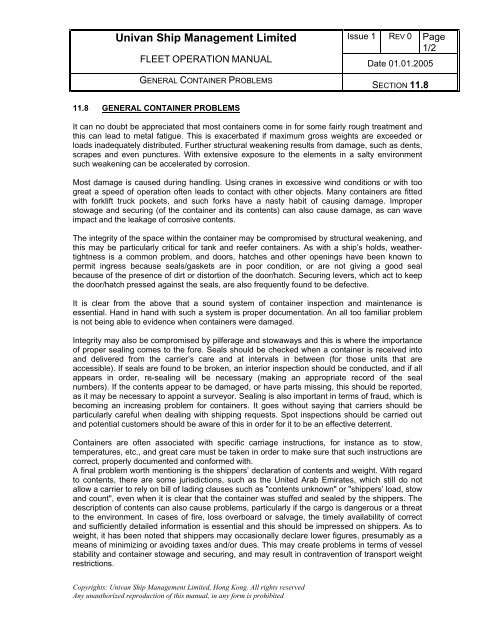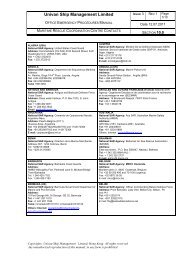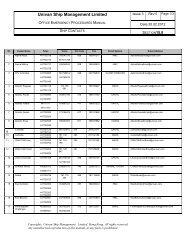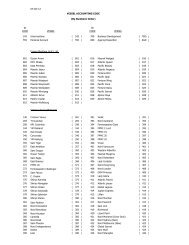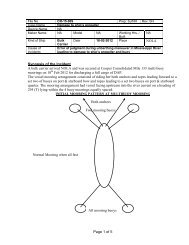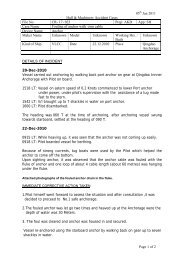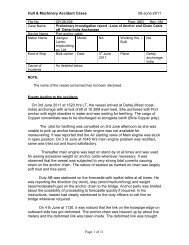Section: 11 CARGO OPERATIONS - Univan
Section: 11 CARGO OPERATIONS - Univan
Section: 11 CARGO OPERATIONS - Univan
Create successful ePaper yourself
Turn your PDF publications into a flip-book with our unique Google optimized e-Paper software.
<strong>Univan</strong> Ship Management Limited Issue 1 REV 0 Page<br />
1/2<br />
FLEET OPERATION MANUAL Date 01.01.2005<br />
GENERAL CONTAINER PROBLEMS<br />
<strong>11</strong>.8 GENERAL CONTAINER PROBLEMS<br />
Copyrights: <strong>Univan</strong> Ship Management Limited, Hong Kong. All rights reserved<br />
Any unauthorized reproduction of this manual, in any form is prohibited<br />
SECTION <strong>11</strong>.8<br />
It can no doubt be appreciated that most containers come in for some fairly rough treatment and<br />
this can lead to metal fatigue. This is exacerbated if maximum gross weights are exceeded or<br />
loads inadequately distributed. Further structural weakening results from damage, such as dents,<br />
scrapes and even punctures. With extensive exposure to the elements in a salty environment<br />
such weakening can be accelerated by corrosion.<br />
Most damage is caused during handling. Using cranes in excessive wind conditions or with too<br />
great a speed of operation often leads to contact with other objects. Many containers are fitted<br />
with forklift truck pockets, and such forks have a nasty habit of causing damage. Improper<br />
stowage and securing (of the container and its contents) can also cause damage, as can wave<br />
impact and the leakage of corrosive contents.<br />
The integrity of the space within the container may be compromised by structural weakening, and<br />
this may be particularly critical for tank and reefer containers. As with a ship’s holds, weathertightness<br />
is a common problem, and doors, hatches and other openings have been known to<br />
permit ingress because seals/gaskets are in poor condition, or are not giving a good seal<br />
because of the presence of dirt or distortion of the door/hatch. Securing levers, which act to keep<br />
the door/hatch pressed against the seals, are also frequently found to be defective.<br />
It is clear from the above that a sound system of container inspection and maintenance is<br />
essential. Hand in hand with such a system is proper documentation. An all too familiar problem<br />
is not being able to evidence when containers were damaged.<br />
Integrity may also be compromised by pilferage and stowaways and this is where the importance<br />
of proper sealing comes to the fore. Seals should be checked when a container is received into<br />
and delivered from the carrier’s care and at intervals in between (for those units that are<br />
accessible). If seals are found to be broken, an interior inspection should be conducted, and if all<br />
appears in order, re-sealing will be necessary (making an appropriate record of the seal<br />
numbers). If the contents appear to be damaged, or have parts missing, this should be reported,<br />
as it may be necessary to appoint a surveyor. Sealing is also important in terms of fraud, which is<br />
becoming an increasing problem for containers. It goes without saying that carriers should be<br />
particularly careful when dealing with shipping requests. Spot inspections should be carried out<br />
and potential customers should be aware of this in order for it to be an effective deterrent.<br />
Containers are often associated with specific carriage instructions, for instance as to stow,<br />
temperatures, etc., and great care must be taken in order to make sure that such instructions are<br />
correct, properly documented and conformed with.<br />
A final problem worth mentioning is the shippers’ declaration of contents and weight. With regard<br />
to contents, there are some jurisdictions, such as the United Arab Emirates, which still do not<br />
allow a carrier to rely on bill of lading clauses such as "contents unknown" or "shippers’ load, stow<br />
and count", even when it is clear that the container was stuffed and sealed by the shippers. The<br />
description of contents can also cause problems, particularly if the cargo is dangerous or a threat<br />
to the environment. In cases of fire, loss overboard or salvage, the timely availability of correct<br />
and sufficiently detailed information is essential and this should be impressed on shippers. As to<br />
weight, it has been noted that shippers may occasionally declare lower figures, presumably as a<br />
means of minimizing or avoiding taxes and/or dues. This may create problems in terms of vessel<br />
stability and container stowage and securing, and may result in contravention of transport weight<br />
restrictions.


